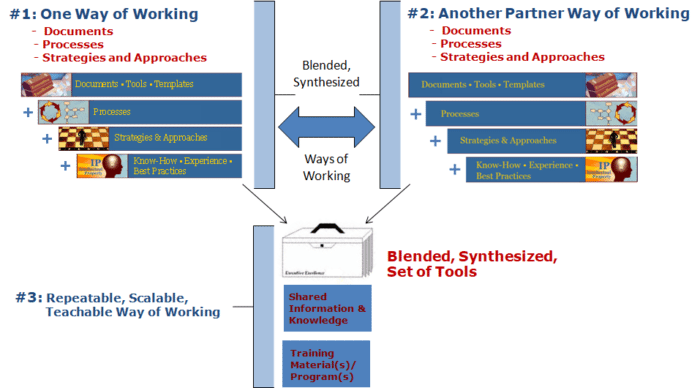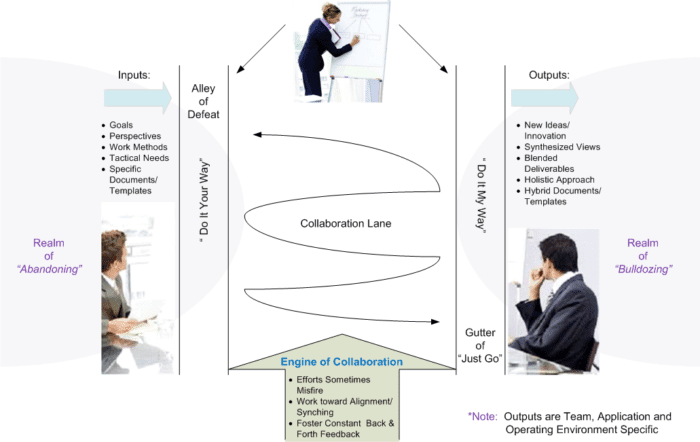Strong Point’s Leadership Rule #6: Facilitate Collaboration
Collaboration is one of those “touchy feely” words like Kindness that connotes a warm, fuzzy feeling. Feeling kindness, is different, however, than being kind, especially when kindness is required for a person, or in an environment that is anything but kind. Being kind to an abrasive and thoughtless colleague takes a good deal of self control and requires the disciplined response of a mature leader who has worked hard to optimize his or her emotional intelligence. Being kind is a lot harder than feeling a sense of kindness.
Collaboration is a lot like kindness in this regard. It feels wonderful to bounce ideas off a team member and to feel collaborative and energized by his or her thoughts and ideas. A past Cisco Blog written by Carlos Dominguez quotes Eric Schmidt, the Chairman and the former CEO of Google, about his interesting and sarcastic thoughts on collaboration:
He said, “When you say collaboration, the average 45-year-old thinks they know what you’re talking about: teams sitting down, having a nice conversation with nice objectives and a nice attitude.” (smile)
In a May 2017 Harvard Business Review entitled How to Capture Value from Collaboration, Especially If You’re Skeptical About It written by Heidi K. Gardner and Herminia Ibarra, the authors explain:
“Many of us recognize intellectually that we need others’ knowledge to solve big problems, yet we still lack the motivation to collaborate.”
Their article goes on to say that:
“Teamwork all too often feels inefficient (search and coordination costs eat up time), risky (can I trust others to deliver for my client?), low value (our own area of expertise always seems most critical), and political (a sneaky way of self-promoting to other areas of one’s firm). Lurking behind these reservations may be concerns about losing relevance, becoming one of those “charismatic” leaders so often criticized as “all form, no substance.”
My work through Strong Point Strategy supports Heidi and Herminia’s findings about collaboration. I’ve personally heard “in-the-moment” comments such as these, during important collaborative working sessions:
“This is a waste of my time!!”
“Having people sitting around listening to others prevents them from getting their own work done!”
“ While it looks Good Live, I’m not too sure how collaboration is helping us; because at the end of the day, we all go back to our desks and do work in a way that works best for us”
Collaboration is an expansive topic. There are a few core definitions. There are many, many interpretations of the definitions. If you look for the most common definition of Collaboration you will find something like this:
Definition of Collaboration:
col·lab·o·ra·tion: kəˌlabəˈrāSH(ə)n

noun: collaboration; plural noun: collaborations
1. the act of working with someone or a group of people to produce or create something (aka a deliverable)
This definition makes me think of my Pharmaceutical Colleagues in Brand Marketing, as well as Legal, Medical, and Regulatory Affairs, who almost continuously and collaboratively design, develop and refine the physician and patient awareness materials about medicines. When these stakeholders collaborate, they do so, on an intellectual, functional, and technological basis. They know what collaboration means. They consistently collaborate. They use a variety of digital collaboration tools. They produce collaborative results. This kind of collaboration is tactical and task-oriented. In my experience, collaboration at this level, works effectively and occurs often.
It’s harder to collaborate, and even build the case for collaboration, when the outcome is less tangible than a specific document or deliverable. If the outcome is to achieve shared understanding about an important initiative among participants from a wide variety of functional business teams, vendors and partners, for example; then it’s highly likely that someone on that team is going to feel that time is wasted during the collaborative process. Collaboration used for the sake of achieving common understanding, necessarily highlights the unevenness in participants’ knowledge and works to cultivate conceptual standards that everyone can absorb. Shared understanding is a prerequisite for predicting the results of synchronized execution from a group of diverse team members.

Similarly, a collaboration intended to achieve a blended approach to solving a core business challenge is equally difficult. If two companies are collaborating on an important project, and they have two very different ways of working that have been raised, internally, to the level of best-practice, then blending both best practices into a combined and synthesized way of working to support the project requires collaboration. I will go farther and say that blending and synthesizing disparate approaches to solving problems requires that collaboration itself be raised to a best practice.
“So how can Collaboration be raised to a best practice?,” you ask. One immediate way to increase and improve collaboration is to identify or develop projects for which collaboration seems necessary, and can be used as the means to reach a shared goal between two or more partner groups. Next, hire a trained facilitator or identify one or two team members to become trained facilitators. Lastly, work to facilitate collaboration…and do it a LOT. Collaboration, like any other Leadership Discipline, requires practice, and lots of it.
In a recent Strong Point Engagement, a client-leader, expressed open frustration, during a working session. He explained, “I feel like I am always giving up and giving in and compromising my ideas and plans in a way that they become assimilated into the whole until they are unrecognizable, even to me!” I listened and replied, “That’s what collaboration often feels like!”
Facilitation is an important Leadership Skill. A mid-1970s book called How to Make Meetings Work , by Doyle and Strauss, explains that facilitators are “neutral servants” responsible for making sure participants involved in a collaborative working session are using the most effective approaches to solve problems and make decisions while blending thoughts and plans and reaching consensus. The role of facilitators in business has grown dramatically in recent years. The need for facilitators increases as work becomes more and more global, and stakeholders become more and more culturally diverse. Facilitation is a lost art that’s in need of a renaissance, in my opinion.

Trained facilitators can state and restate each partner’s position, plans, and approaches and then work to smooth the conversation and synthesize the work until a blended outcome is reached. Facilitators keep working session participants in the “Collaboration Lane” by preventing any member from “bulldozing” or “abandoning” his or her contributions in the effort to collaborate.
Effective Leaders Facilitate Collaboration
Learn, Practice and Master these skills yourself as a Leader. Create an environment where these skills are valued and taught in your workplace. Enable colleagues to strengthen facilitation and collaboration skills through team and project work. Create regular monthly working sessions to review and refine these two skills. Your efforts will show in increased business strength and leadership capability.
Here’s a short list of the Business Benefits of having individual and operational mastery of Facilitation and Collaboration.
| Business Benefits of Facilitation | Business Benefits of Collaboration |
|---|---|
| 1. Deeper Understanding of Individual Communication Styles | 1. Greater Appreciation for the Depth and Diversity of Thoughts, Ideas and Plans of Employees, Vendors and Partners |
| 2. Advanced Operational Ability to Manage and Positively Channel Discontent and Discord | 2. A Greater Sense of Patience and Tolerance for differing and counter-intuitive views and beliefs |
| 3. Organizational Advancement of Listening Skills and Ability | 3. Greater Experience with testing, trying and adapting a wide variety of methods and best-practices |
| 4. Richer, More Meaningful Business Processes | 4. More Opportunities to Unleash Innovation |
| 5. Enhanced levels of Inclusion and Connectedness within and across internal business units and external partnerships | 5. Development of a Learning Culture that seeks to ever improve |




